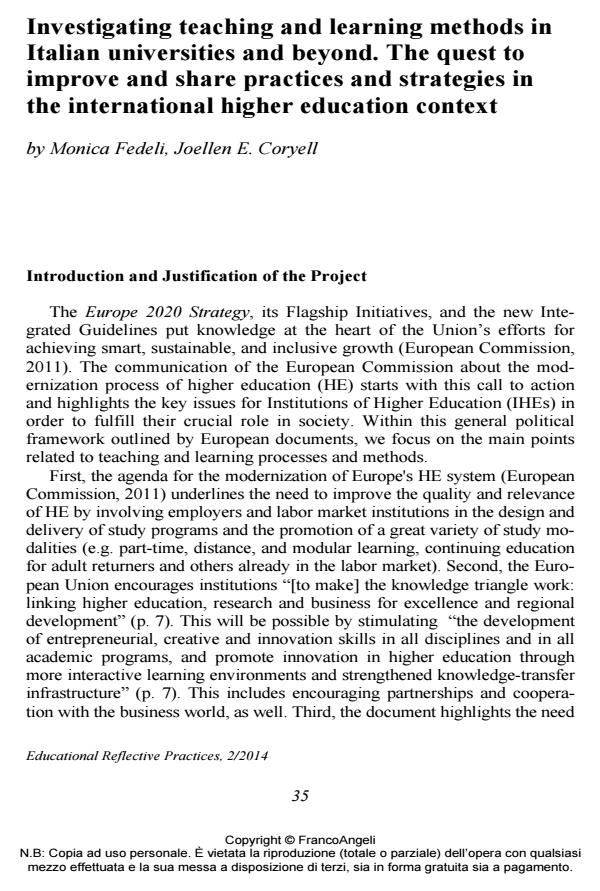Investigating teaching and learning methods in Italian universities and beyond. The quest to improve and share practices and strategies in the international higher education context
Journal title EDUCATIONAL REFLECTIVE PRACTICES
Author/s Monica Fedeli, Joellen E. Coryell
Publishing Year 2015 Issue 2014/2
Language English Pages 16 P. 35-50 File size 121 KB
DOI 10.3280/ERP2014-002003
DOI is like a bar code for intellectual property: to have more infomation
click here
Below, you can see the article first page
If you want to buy this article in PDF format, you can do it, following the instructions to buy download credits

FrancoAngeli is member of Publishers International Linking Association, Inc (PILA), a not-for-profit association which run the CrossRef service enabling links to and from online scholarly content.
The present paper aims to describe the first phase (12 months) of an Italian research unit, which is part of a more extensive three year project that endeavored to: design innovative programs for higher education, to promote personalized learning, to build on job competencies, to value talents, to create new work opportunities, and to provide positive strategies in higher education to support young adults during their employment emergency as a response to the socio-economic crisis and as a citizenship action. In response, a consortium of universities and researchers, called Emp&Co (Employability and Competences) was created. The project involves six Italian Universities (Padova, Firenze, Siena, Napoli, Molise, Roma Sapienza), and Dr. Monica Fedeli from the University of Padova is the Principal Investigator. Dr. Fedeli’s research group is focusing on the innovation of teaching and learning methods and promotion of personalized programs in order to modernize university didactics, to encourage the university-business dialogue, and to promote employability. In the first phase of the project, a literature review was conducted and an analysis of student evaluation questionnaires on didactics, from 8 Italian, 3 American, 5 European, 1 Canadian, and 1 African University was completed to compare and learn from the different ways in which courses are evaluated by students in the different academic contexts. The goal at the end of the first year is the creation of a questionnaire template focused on teaching and learning methods, in order to gain a better understanding of student perspectives in our country. Additionally, we hope to implement strategies that will improve university didactics as requested by all European Union declarations. This paper introduces the overall study and the foregrounding work done with Dr. Joellen Coryell from Texas State University in the United States, who is a consultant to the University of Padova in the areas of adult and higher education teaching and learning.
- Theory and Practice for Understanding Process and Outcomes of Transformative Learning Claudio Melacarne, Alessandra Romano, in EDUCATIONAL REFLECTIVE PRACTICES 2/2019 pp.214
DOI: 10.3280/ERP2018-002014 - Effective Multimodal Interaction for Online and Hybrid Teaching Antonella Giacosa, pp.27 (ISBN:978-3-031-77384-6)
Monica Fedeli, Joellen E. Coryell, Investigating teaching and learning methods in Italian universities and beyond. The quest to improve and share practices and strategies in the international higher education context in "EDUCATIONAL REFLECTIVE PRACTICES" 2/2014, pp 35-50, DOI: 10.3280/ERP2014-002003